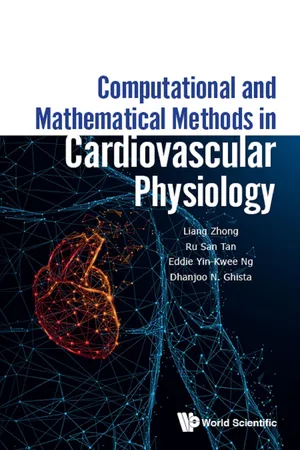
Computational and Mathematical Methods in Cardiovascular Physiology
Liang Zhong, Ru San Tan;Eddie Yin Kwee Ng;Dhanjoo N Ghista
- 460 Seiten
- English
- ePUB (handyfreundlich)
- Über iOS und Android verfügbar
Computational and Mathematical Methods in Cardiovascular Physiology
Liang Zhong, Ru San Tan;Eddie Yin Kwee Ng;Dhanjoo N Ghista
Über dieses Buch
Cardiovascular diseases (CVD) including heart diseases, peripheral vascular disease and heart failure, account for one-third of deaths throughout the world. CVD risk factors include systolic blood pressure, total cholesterol, high-density lipoprotein cholesterol, and diabetic status. Clinical trials have demonstrated that when modifiable risk factors are treated and corrected, the chances of CVD occurring can be reduced. This illustrates the importance of this book's elaborate coverage of cardiovascular physiology by the application of mathematical and computational methods.
This book has literally transformed Cardiovascular Physiology into a STEM discipline, involving (i) quantitative formulations of heart anatomy and physiology, (ii) technologies for imaging the heart and blood vessels, (iii) coronary stenosis hemodynamics measure by means of fractional flow reserve and intervention by grafting and stenting, (iv) fluid mechanics and computational analysis of blood flow in the heart, aorta and coronary arteries, and (v) design of heart valves, percutaneous valve stents, and ventricular assist devices.
So how is this mathematically and computationally configured landscape going to impact cardiology and even cardiac surgery? We are now entering a new era of mathematical formulations of anatomy and physiology, leading to technological formulations of medical and surgical procedures towards more precise medicine and surgery. This will entail reformatting of (i) the medical MD curriculum and courses, so as to educate and train a new generation of physicians who are conversant with medical technologies for applying into clinical care, as well as (ii) structuring of MD-PhD (Computational Medicine and Surgery) Program, to train competent medical and surgical specialists in precision medical care and patient-specific surgical care.
This book provides a gateway for this new emerging scenario of (i) science and engineering based medical educational curriculum, and (ii) technologically oriented medical and surgical procedures. As such, this book can be usefully employed as a textbook for courses in (i) cardiovascular physiology in both the schools of engineering and medicine of universities, as well as (ii) cardiovascular engineering in biomedical engineering departments worldwide.
Contents:
- Acknowledgements and Dedications
- Preface
- Heart Anatomy, Physiology and Imaging:
- Anatomy and Physiology of the Heart (Liang Zhong, Ru San Tan and Dhanjoo N Ghista)
- Computed Tomography: Applications in Imaging of Cardiac Structures (Shoen Choon Seng Low)
- Coronary Artery Heart Disease: Phyiology, Stenosis Assessment, and Percutaneous Interventions (Jiang Ming Fam)
- Computational and Mathematical Methods in Cardiovascular Physiology:
- Fluid Mechanics and the Cardiovascular System (Dhanjoo N Ghista, Foad Kabinejadian, and Joseph L Bull)
- Cardiac Image Segmentation and Shape Modeling (Min Wan, Liang Zhong and Ru San Tan)
- 2D FSI Simulation of Flow in Patient-specific Left Ventricle (Boyang Su, Siamak N Doost and Liang Zhong)
- 3D Simulation of Flow in Patient-specific Left Ventricle (Boyang Su and Liang Zhong)
- Computational and Mathematical Methods in Vascular Physiology:
- Coronary Artery Stenosis: Flow, Assessment, and Interventions (Foad Kabinejadian, Dhanjoo N Ghista, Mehul R Bhaljia, Owen N Mogabgab and Joseph L Bull)
- Artery Buckling and Atherosclerotic Plaque Rupture under High Lumen Pressure (Seyed Saeid Khalafvand and Ali C Akyildiz)
- Hemodynamics Simulation in the Left Anterior Descending Coronary Artery Tree (Boyang Su, Foad Kabinejadian, Yunlong Huo, Ghassan Kassab, Hwa Liang Leo and Liang Zhong)
- Noninvasive Hemodynamic Assessment of the Significance of Coronary Artery Disease (Jun-Mei Zhang, Ru San Tan, Ris Low, Leok Poh Chua, Swee Yaw Tan, Aaron Sung Lung Wong, Terrance Siang Jin Chua, Tian Hai Koh, Soo Teik Lim and Liang Zhong)
- Computational and Mathematical Methods in Cardiovascular Devices:
- Cardiac Devices and CFD: Current State and Challenges (Siamak N Doost, Liang Zhong and Yosry S Morsi)
- Ventricular Assist Device: Hemodynamic Simulation and Design Analysis (Boyang Su and Leok Poh Chua)
- The Percutaneous Mitral Valve Stents: Finite Element Based Design, Crimpability Features and Fatigue Performance (Fangsen Cui and Gideon Praveen Kumar)
- Bileaflet Mechanical Heart Valves: In Vitro Study Based on Hemodynamic 3D Simulation (Yee Han Kuan, Vinh-Tan Nguyen and Hwa Liang Leo)
- Index
Readership: The book will attract a wide range of readers: academics, biomedical engineers, cardiologists, students, researchers, employees of funding agencies such as the National Institute for Health (NIH). Cardiovascular System;Fluid Mechanics;Physiology;Hemodynamics0 Key Features:
- This book provides a gateway for the new emerging scenario of (i) science and engineering based medical educational curriculum, and (ii) technologically framed medical and surgical procedures
- As such, this book can be usefully employed as a textbook for courses in (i) cardiovascular physiology in both the schools of engineering and medicine of universities, as well as (ii) cardiovascular engineering in biomedical engineering departments of universities world-wide
Häufig gestellte Fragen
Information
Section II
Computational and Mathematical Methods in Cardiovascular Physiology
| 4 | Fluid Mechanics and the Cardiovascular System |
and Joseph L. Bull †;
†Department of Biomedical Engineering,Tulane University,
New Orleans, LA, USA
4.1Introduction




Inhaltsverzeichnis
- Cover
- Halftitle
- Title
- Copyright
- Contents
- Acknowledgements and Dedications
- Preface
- Section I Heart Anatomy, Physiology and Imaging
- Section II Computational and Mathematical Methods in Cardiovascular Physiology
- Section III Computational and Mathematical Methods in Vascular Physiology
- Section IV Computational and Mathematical Methods in Cardiovascular Devices
- Index